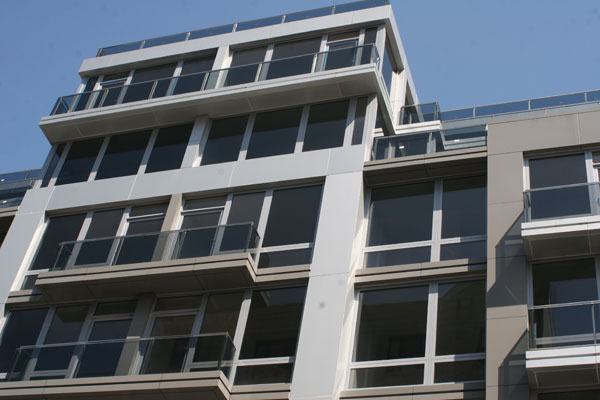
Photo by: courtesy of Right to the City Coalition
When this now vacant 35-unit building in Central Harlem went on the market in April 2009, its units were selling at about $721,000, according the Right to the City Report.
A new report by a coalition of community organizations found 264 luxury residential developments sitting vacant throughout the city, like so many crystal glasses lined up for a party that never started. The Right to the City Coalition, the report’s authors, wants to turn them into homes for homeless families and individuals.
“It just seems very logical that if these buildings are vacant and they are warehousing them, while we have families living in shelters, living in SROs, these apartments should be taken over by the city through tax foreclosure, like any other building,” said Cerita Parker, a leader with Mothers on The Move, an activist community organization in the South Bronx. “These are homes and we have homeless people.” The report calls for the city to take over buildings that are behind on taxes and to use eminent domain to acquire others.
Michael Slattery, senior vice president at The Real Estate Board of New York, said real estate is more complicated than that. “The call for the confiscating of private property for ideological reasons is the most startling since the Russian Revolution,” he said.
“To simplify it, and say that we should take private property and turn it over to the homeless population, it seems to me that we shouldn’t try to feast on someone’s misfortune,” Slattery said. He was referring to the misfortune of a developer whose property is not selling.
“The tax foreclosure process would be a means to transfer them to a non-profit manager. There are 138 buildings that are over a year delinquent,” said David Dodge, coordinator for the Right to the City-NYC Alliance.
Using tax foreclosure to take over the buildings is complicated by the fact that the city sells its tax liens to private investors, who then control the debt. However, some properties, usually highly distressed buildings full of tenants are held off the tax lien sale and transferred to developers interested in managing them as affordable housing. Using this third party transfer process for high-end vacant buildings would require changes to the selection criteria currently used for buildings.
The alliance has targeted vacant condominiums as potential housing solutions for people without homes before. However this is the first time the group has produced a systematic census of empty buildings. Relying on member organizations such as Make the Road New York and Mothers on the Move, the group canvassed eight city neighborhoods with what members suspected were high concentrations of high end real estate sitting fallow.
They found 41 buildings in the South Bronx that are completely or mostly vacant; 50 in Bushwick; 23 in Greenwich Village and Chelsea. The supply doesn’t meet the demand of people in those neighborhoods, according to Right to the City’s calculations: In the South Bronx the average price per condo on the market is $943,514, but the average household income is $19,111. In Bushwick, the average condo is listed at $336,035, with a neighborhood household income of $35,000. Incomes are higher in the West Village and Chelsea, reaching $92,000, but not high enough to afford the area’s $4.7 million average condo price.
Last year the Department of Housing Preservation and Development tried to play matchmaker for developers and people in need of permanent homes. The city offered developers whose buildings were sitting like socialites all dressed up with nowhere to go a package of tax breaks, in exchange for dropping rents to levels people with moderate incomes could afford.
Developers decided they’d rather sit by the phone, waiting for the market to improve. No one took the city up on the deal.
Slattery explained that investors might balk at turning buildings into low income housing, and said neighbors and condo owners already in the buildings would be resistant to new neighbors from homeless shelters.
But those neighbors have the wrong idea, Parker said. “We are talking about viable families that once were living in homes and now are not,” because rents have increased in the very neighborhoods where the vacant condos sit.
While wholesale city takeover of vacant buildings is unlikely given the power of the real estate industry, the complexity of the citywide real estate market and the severe fiscal constraints faced by city agencies and the housing authority, smaller steps are being considered.
Councilwoman Melissa Mark-Viverito, whose East Harlem district is checkered with empty developments, introduced a bill to require an annual census of vacant buildings citywide. Similar legislation has been introduced in past years. “We want to use this to force other public conversations,” she said.
Mark-Viverito and others also support Right to the City’s proposal for a vacancy registration fee, similar to what is used in Boston. Owners would have to pay a per unit fee (RTTC suggests $1,000 of $1,500) to the city for properties held vacant for more than a year. The goal is to discourage warehousing. “We have to constantly be looking at alternatives, seeing what we can learn,” Mark- Viverito said. “It’s not that we don’t have people who are in need of housing.”







